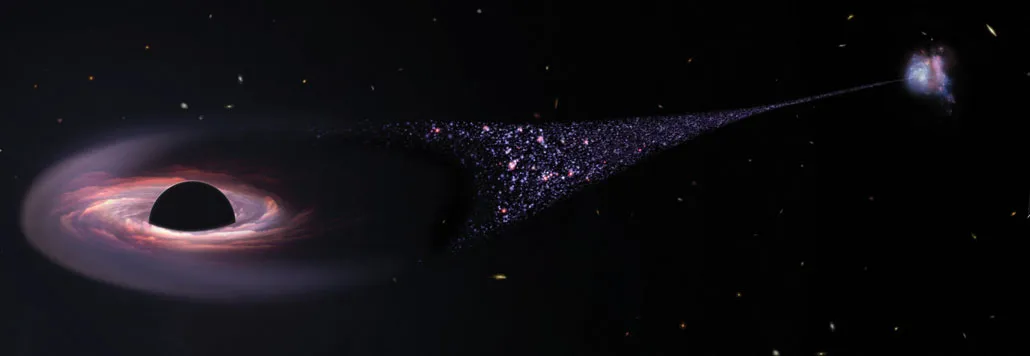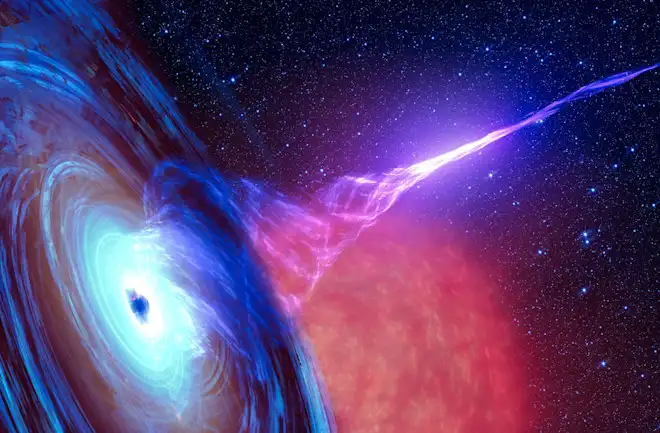Black holes are among the most enigmatic and awe-inspiring phenomena in the universe. With gravitational fields so intense that not even light can escape, they behave more like portals to unknown realms than celestial objects. Although we can’t see them directly, their influence on nearby stars and gas reveals their invisible presence. As scientists learn more about these dark behemoths, black holes continue to challenge our understanding of physics and reality itself.
1. Black Holes Warp Time and Space
Venture too close to a black hole and you’ll experience time differently. The intense gravity near a black hole slows time dramatically so and distorts space. You might find yourself caught in an accretion disk of swirling matter, circling the event horizon, the “point of no return.” Pass that threshold and gravity takes over completely. You’d be stretched into a long thread, a phenomenon known as “spaghettification,” on your way toward the singularity a point of infinite density where the known laws of physics fall apart.
2. They Come in All Sizes
From Tiny to Tremendous
Black holes vary wildly in size. The most common type, stellar-mass black holes, form when massive stars collapse under their own gravity after a supernova explosion. These typically weigh in at about 10 times the mass of the sun. Supermassive black holes, on the other hand, can tip the cosmic scales at billions of solar masses. These giants reside at the center of most galaxies, including our own the Milky Way which orbits around Sagittarius A*, a supermassive black hole with about 4 million times the mass of our sun.
Scientists have also proposed the existence of primordial black holes ultra-small black holes that may have formed just after the Big Bang and recently discovered “stealth” black holes that consume matter more slowly and are therefore harder to detect.
3. The Universe Is Packed With Black Holes
Estimates suggest the Milky Way alone contains 10 million to 1 billion stellar-mass black holes. Multiply that by the 100 billion galaxies believed to exist, and the numbers become nearly incomprehensible. Add in supermassive black holes typically one per galaxy and other theoretical types, and it’s safe to say we’re living in a universe teeming with invisible giants.

4. They Don’t Just Consume They Also Spit Things Out
Black holes aren’t roaming predators hunting planets, but they do devour anything that ventures too close. Astronomers have observed black holes consuming stars sometimes for years. Surprisingly, these cosmic entities don’t just absorb they also eject. Matter that skirts too close to the edge of the event horizon but doesn’t fall in can be flung back out into space as compact, high-speed projectiles, traveling up to 20 million miles per hour. These so-called “spitballs” could potentially threaten anything in their path including, one day, Earth.
5. Supermassive Black Holes Can Create Stars and Regulate Galaxies
More Than Just Destruction
It turns out black holes play a creative role too. Recent findings suggest that expelled material from supermassive black holes can condense into new stars, sometimes far outside their host galaxies. Beyond star creation, they also seem to influence how many stars a galaxy forms. A study from 2018 found that galaxies with smaller central black holes tend to stop forming stars sooner, indicating that the size of a galaxy’s black hole may act as a cosmic thermostat for star production.
6. You Can (Sort of) See One
In 2019, the Event Horizon Telescope made history by capturing the first image of a black hole’s event horizon the boundary beyond which nothing can return. The subject was the supermassive black hole in galaxy Messier 87, 53 million light-years away. A follow-up image of our own Sagittarius A* soon followed. Though the photos show a glowing halo of gas and not the black hole itself, these images provide valuable insight into how these celestial giants behave and how they bend the laws of physics.
7. Some May Be Synchronized Across the Cosmos
In a recent puzzling discovery, astronomers in South Africa observed that the jets emitted from black holes in several galaxies appeared to be aligned despite being separated by hundreds of millions of light-years. This mysterious alignment suggests the black holes are spinning in the same direction. The synchronization could hint at conditions during early galaxy formation that current theories have yet to fully explain.
Why Black Holes Matter
Studying black holes doesn’t just satisfy cosmic curiosity. Their behavior offers clues about the origins of the universe, the nature of gravity, and the structure of space-time. They also impact their surroundings in ways that ripple through entire galaxies. By learning more about them, we gain deeper insight into the forces that shape our cosmic neighborhood and even our own planet.
How Space Exploration Supports Earth
Exploring the cosmos has far-reaching effects. Technologies developed for space science have contributed to climate monitoring, improved GPS systems, and enhanced our ability to understand Earth’s changing environment. In the case of black holes, peering into their mysteries encourages innovation and helps us better appreciate the interconnected nature of the universe.





